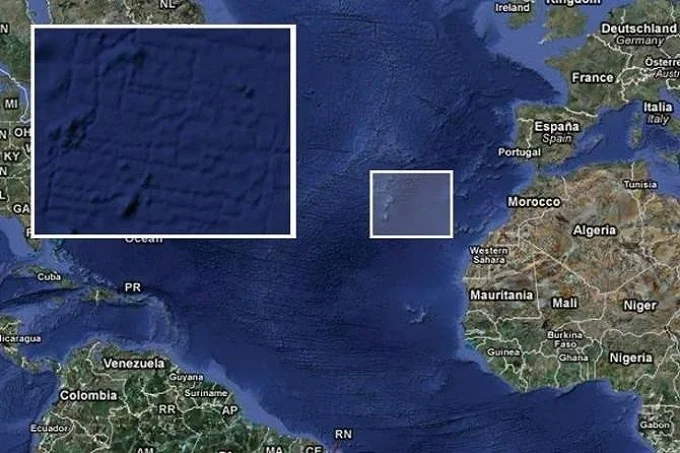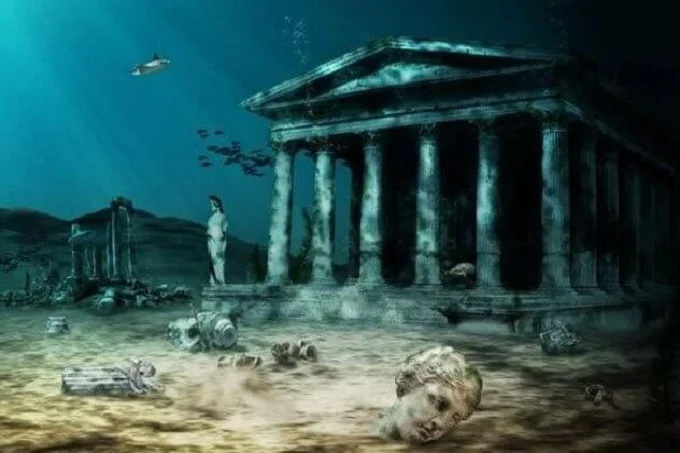What happened to Atlantis and where is the lost city of Atlantis believed to be?

There is hardly a person who has never heard the story of the mysterious island-state of Atlantis. Did it exist or not?! And if so, where was it located, who inhabited it and what happened to it?! All these are questions that have not yet been found unambiguous answers…
Once described by Plato, Atlantis has occupied the minds of historians, archaeologists, philosophers and esotericists for many centuries. Moreover, the lack of scientifically confirmed evidence of the existence of this civilization does not stop its seekers and researchers at all.
Plato’s narrative
For the first time, the ancient Greek philosopher, the disciple of Socrates and teacher of Aristotle – Plato of Athens (427-347 BC) told mankind about the island-state of Atlantis.
In his works “Timaeus” and “Critias”, presented in the form of dialogues between Socrates and the Pythagorean Timaeus, Plato argued about the best state system. During the dispute, a third participant joined the conversation – the Athenian politician Critias. He told about the war of Athens with the state of Atlantis. Critias learned this story from his grandfather Critias the elder, and he, in turn, heard it in the retelling of the poet and politician Solon, who heard about it from the priests in Egypt.
According to Plato, 9,000 years ago, Athens went to war with the island state of Atlantis. “This island was larger than Libya (Africa – Author’s note) and Asia, taken together.” And Atlantis came down with its might on Athens. Frightened, the allies left the Athenians, but the brave men repelled the onslaught of the Atlanteans and defeated them. After that, the enslaved peoples were liberated, and Atlantis itself was overtaken by a grandiose natural disaster, which killed not only all the Atlanteans, but also the Athenian army, and also forever submerged this state on the seabed.
The philosopher describes Atlantis as a plain 3,000 stadia long (540 kilometers) and 2,000 stadia wide (360 kilometers). The capital of Atlantis was located on an island-hill located 50 stages (8-9 kilometers) from the sea. To protect against the elements, Poseidon, the ancestor of the Atlanteans, fenced the hill with the city with three water and two land rings. And the Atlanteans themselves threw bridges over these rings and dug channels, so that ships could sail directly to the capital. To get the latest stories, install our app here.
“The island on which the palace stood… as well as earthen rings and a bridge a kilometer wide (30 meters – Author’s note) the kings circled with circular stone walls and put towers and gates everywhere on the bridges at the passages to the sea…”
Plato described in such detail the wealth, beauty, and fertility of the island he had never seen, that the reader had the feeling that the author had seen it all with his own eyes. At the same time, the philosopher reproached the Atlanteans that in them, the divine nature gave way to human greed, avarice, and pride. Outraged by this, Zeus decided to exterminate the Atlanteans and called a meeting of the gods. This ends Plato’s dialogue.
Islands in the ocean
Since the Renaissance, when Plato’s works again found their readers, the search for the mysterious Atlantis occupied the minds of mankind. Since then, dozens of versions of its location, as well as its death, have been put forward, and in the 50s of the XX century, even the doctrine of Atlantology appeared.
One of the dominant hypotheses of the location of Atlantis boils down to its search in the Atlantic Ocean, west of the Pillars of Hercules. This is how the Greeks, including Plato, called the rocks Gibraltar and Ceuta, between which the Strait of Gibraltar was located. Plato wrote that Atlantis was located to the west of the Pillars of Hercules, opposite the Atlas Mountains. Therefore, Atlantis must be located near Gibraltar, between Spain and Morocco.

By the way, Morocco, among the Greeks, was the abode of the titan Atlanta, from whose name the names of the Atlantic Ocean and the Atlas ridge originated. From it, the very name of Atlantis was formed – “the country of Atlanta”.
A number of researchers claim that the remnants of the once-mighty island are the Canary Islands. So, according to the theory of Atlantologists, the Canaries are the remains of a bridge “thrown” from Africa to Atlantis. However, the connection with Atlantis via the “Canary Bridge” was cut off even earlier than with Africa, which can be traced to the relief of the ocean floor.
In 2009, an English specialist in aerial photography of the seabed, Bernie Bamford, made a statement that he saw Atlantis on one of the images of the Atlantic Ocean, five hundred kilometers from the Canary Islands.
At a depth of 5 kilometers, Bamford saw a rectangle consisting of a grid of intersecting lines. They seemed to him like the streets of a flooded city. To get the latest stories, install our app here.
Moreover, according to Bamford, the city surpassed modern megacities! However, the circular channels described by Plato were not visible in the picture with lines and rectangles. In addition, skeptics believed that these were not genuine lines, but virtual directions of sonars (devices used to detect and study underwater objects). Although there should be no gaps in the sonar lines, but they were in the picture.
In the 70-80s of the last century, five hundred kilometers west of the Strait of Gibraltar, near the Azores, near the Ampere seamount, scientific expeditions on the ships “Academician Petrovsky” and “Academician Kurchatov” discovered strange vertical structures similar to the walls of an ancient city.
They protruded from a layer of light sand and were also located at right angles, moreover, scientists noticed blocks separated by seams. But most importantly, the study of a piece of basalt from the top of the mountain showed that such a rock could only have been formed on the land about 12 thousand years ago, which fits perfectly into Plato’s narrative.
The ruined Minoans
It is no secret that scientists consider the monuments of writing with a fair degree of skepticism and admit that ancient authors have a variety of hyperboles and allegories.
Therefore, it seems quite reasonable to assume that Atlantis was the prototype of the island of Crete with the highly developed Minoan civilization that existed on it and the island of Santorini in the Mediterranean, partially destroyed by a volcanic explosion. To get the latest stories, install our app here.
That’s just the eruption of a volcano on the island of Strongila (Santorini is part of this giant island), which killed the Minoans, which occurred in the XVII century BC. That is, not for 9000, but for a maximum of 1000 years before Plato. The eruption and earthquake first destroyed the base of the island, and the resulting giant tsunami covered the northern coast of Crete (the largest part of the island metropolis) with a giant wave.
The fields that provided the Minoans with food resources were covered with volcanic ash, which made it impossible to process them. And hunger completed the tragedy. At the same time, the wind rose with volcanic ash bypassed Greece and Egypt, the rivals of the Minoans.
Given the unexpected advantage, the Achaeans (the population of mainland Greece) landed on Crete and enslaved opponents who no longer had the same power.
Describing the capital of Atlantis, Plato mentioned a concentric channel through which ships sailed and went out to sea from there. This description is quite consistent with an island volcanic caldera with an annular shaft and a central island.
Another version boils down to the fact that Atlantis was located in the Black Sea region, and the Black Sea itself was still an inland lake at that time. Presumably, in the VI millennium BC, the level of the Black Sea rose catastrophically – within a year by 60 meters.
This happened as a result of a volcanic eruption, the subsequent tsunami, and the breakthrough of the Bosphorus and the Dardanelles by the waters of the Mediterranean Sea. Scientists explain the biblical legend of the Flood with the same version. Moreover, the flooding of vast territories drove the local population to Europe and Asia, where information about the deceased state came with them.
Interestingly, the Romanian researcher Nicolai Densusheanu, without denying Atlantis the Black Sea location, believes that it was on the territory of modern Romania. He believes that the Lower Danube Plain corresponds to the description of the central plain of Atlantis. It has a rectangular shape measuring 534 by 356 kilometers (3,000 by 2,000 stadia). The Atlas Mountains, in this case, are the Southern Carpathians, and the problem with the island of Romanians is solved by the fact that Plato could easily mix the terms “river”-“sea”-“ocean” and “island”-“country”.
Antarctica, the Andes, and Tibet
Quite a large number of Atlantologists are inclined to believe that Atlantis was located on the territory of Antarctica.
As arguments, supporters of this version cite the Piri Reis map, created in Turkey in 1513 on the basis of ancient maps. According to it, Antarctica was located near the equator, but as a result of the lithospheric shift, it was moved to the South Pole. However, this version does not stand up to criticism from the point of view of geology.
Other supporters of finding Atlantis in the ice refer to the fact that the island, although not located near the equator, had a quite comfortable climate. And the collision of the Earth with a huge meteorite 10-15 thousand years ago caused the displacement of the earth’s axis. As a result, Atlantis moved to the South Pole. To get the latest stories, install our app here.
But modern science has proved that it is impossible to shift the earth’s axis very quickly, and scientific data on the icing of Antarctica say that this happened in other periods.
As already mentioned, humanity began to search for Atlantis in the Renaissance. In this regard, the book “The History of the discovery and Conquest of the province of Peru”, created in 1555 by the Secretary of the Royal Council of Castile, Agustin da Zarate, is of interest. The author writes that Plato’s 9000 years from the flood are 750 ordinary years since according to the Egyptians’ chronology, a modern month was taken into account for a year.
In favor of the search for Atlantis in the Andes, it says that the civilization of the South American Indians had high achievements, which they inherited from another, more ancient civilization. However, hypotheses about the transfer of knowledge to the Indians regularly pop up in other pseudoscientific theories.




